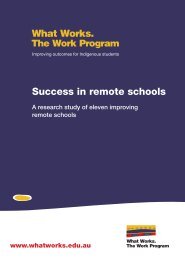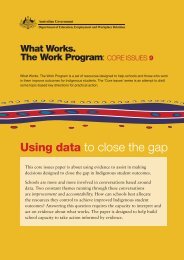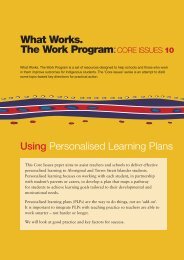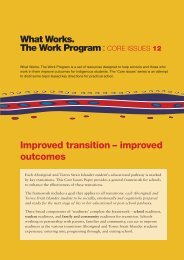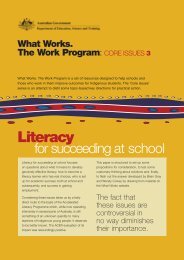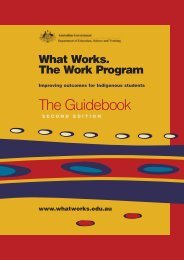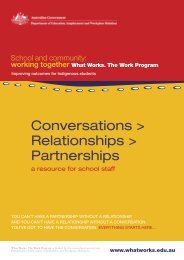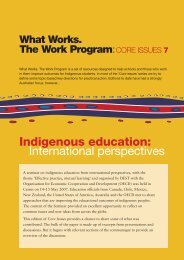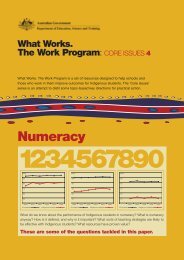Bound for Success Scope and Sequence Statements
Bound for Success Scope and Sequence Statements
Bound for Success Scope and Sequence Statements
- No tags were found...
Create successful ePaper yourself
Turn your PDF publications into a flip-book with our unique Google optimized e-Paper software.
STUDIES OF SOCIETY AND ENVIRONMENTSystems Resources <strong>and</strong> PowerConcept In Year 1the student:In Year 2the student:In Year 3the student:In Year 4the student:In Year 5the student:In Year 6the student:In Year 7the student:In Year 8the student:In Year 9the student:• Knows that good leadershave certain qualities (e.g.says “he is a good leaderbecause he is fair”).• Identifies leaders in thecommunity such as thepoliceman, mayor,Aboriginal elders,teachers.• Knows that leaders should‘show the way’ <strong>and</strong> be agood example.• Identifies the leaders intheir own lives – thosethat they know personally<strong>and</strong> others they know byreputation oradvertisement.• Knows the names <strong>and</strong>responsibilities of localgovernment leaders <strong>and</strong>officials.• Knows Queensl<strong>and</strong>’spolitical leaders (i.e.leaders of the majorpolitical parties) <strong>and</strong> otherlocal/state leaders e.g.Elders, sports leaders.• Identifies tyrannicalleaders in the worlds’history (e.g. SaddamHussein, Adolf Hitler,Milosovic) <strong>and</strong> explainswhy they were not goodleaders.• Knows Australia’s majorleaders in the FederalParliament, includingleaders of the majorpolitical parties, PrimeMinister, Speaker of theHouse, Leaders of theOpposition, ministers).• Describes whatAustralia’s politicalleaders through history areremembered <strong>for</strong>, inparticular, their strengths<strong>and</strong> weaknesses.• Knows who Queensl<strong>and</strong>’smajor leaders in StateParliament are, includingleaders of the majorpolitical parties, Premier,Leader of the Opposition<strong>and</strong> ministers).• Knows who the stateGovernor is.Institutions <strong>and</strong>features ofgovernment.• Knows that there aredifferent levels ofgovernment (local, state<strong>and</strong> Federal).• Describes the decisionmakingprocesses used bylocal government.• Knows different types ofgovernance (e.g.monarchy, aristocracy,tyranny, democracy).• Knows what aconstitutional <strong>and</strong> absolutemonarch are.• Knows that Australia is ademocracy (i.e. governedby the people) <strong>and</strong> has keyfeatures includingelections, parliaments,political parties, aconstitution, freedom ofspeech <strong>and</strong> citizens’participations.• Knows that the role ofParliament is to representpeople, make laws <strong>and</strong>publicly debate issues.• Knows what the majorpolitical parties are inQueensl<strong>and</strong> <strong>and</strong> inAustralia <strong>and</strong> who theirleaders are.• Knows some of the majordemocracies in the world<strong>and</strong> which countries haveconstitutional monarchs.• Explores the functions ofthe three levels ofgovernment.• Describes the structure<strong>and</strong> function of theQueensl<strong>and</strong> Parliament.• Examines the role of keyinstitutions <strong>and</strong> principlesof Australianrepresentative democracy(e.g. Parliament, head ofstate, political parties, free<strong>and</strong> fair elections, secretballot, universal adultsuffrage).• Compare democraciessuch as Australia’s tocountries with other <strong>for</strong>msof government.• Identifies different typesof political systemsaround the world <strong>and</strong> theirkey features.• Knows the majorstructures of theAustralian Parliament <strong>and</strong>how that compares withthe Queensl<strong>and</strong>Parliament.• Knows the role of theGovernor General inFederal Parliament, <strong>and</strong>the name of the currentincumbent.• Describes the role of theConstitution in Australia’spolitical <strong>and</strong> legal systems• Identifies divisions <strong>and</strong>responsibility inAustralia’s three-tierpolitical structures (local,State/Territory <strong>and</strong>Commonwealth.• Explores significantfeatures <strong>and</strong> principles ofdemocracy in Australiaincluding the commongood, separation ofpowers, governmentaccountability <strong>and</strong>parliamentary elections.• Considers the role ofgovernment in developingpolicy <strong>and</strong> <strong>for</strong>mulatinglegislation• Underst<strong>and</strong>s howAustralia’s system ofgovernment is similar to<strong>and</strong> different from otherdemocracies.- Influencingdemocratic decisionmaking.• Knows that ads on TV areused to get our attention<strong>and</strong> try <strong>and</strong> make us dothings.• Lists examples of media<strong>and</strong> the types ofin<strong>for</strong>mation theycommunicate (e.g.billboards, advertisements,newspapers).• Lists the mediaadvertisements that theylike <strong>and</strong> say why they likethem (e.g. says “I reallylike the ad aboutMcDonalds because I likethe girl <strong>and</strong> boy in it <strong>and</strong>they look like they like thefood they are eating”).HPE• Knows that through themedia we receivedifferent types ofin<strong>for</strong>mation such as aboutthe people <strong>and</strong> the culturalgroups they belong to. A• Explores the ways inwhich the mediacommunicates messages toinfluence people (e.g.through televisioncommercials that warn usabout smoking, or TVnews programs in<strong>for</strong>mingus of a natural disaster, orsigns telling us not to droplitter).• Identifies examples of howviews <strong>and</strong> ideas arecommunicated through themedia <strong>and</strong> ICT (e.g.advertisements promotinga political party in anelection OR newspaperarticles in<strong>for</strong>ming parentsof the new starting age <strong>for</strong>school OR internetwebsites providingin<strong>for</strong>mation about newwater restrictions in a• Knows what values are<strong>and</strong> can list some of thevalues that their familyhas or that the school has(e.g. respect, compassion)<strong>and</strong> can explain in theirown words, what thesevalues mean.• Knows there are ‘twosides to every story’ <strong>and</strong>can role play to see thingsfrom different points ofview. HPE• Engages with values thatare important toAustralian democracy.• Compares the ways that anissue or event can beportrayed in the media <strong>and</strong>how this can influencepeople’s views <strong>and</strong>actions. T• Identifies the values thatare portrayed in the media(e.g. on watching an adabout fast food on TVsays “that ad makes it lookcool to eat food fromSubway” or, on reading abillboard showing rubbishon the beach surroundedby pigs says “that admakes it look messy <strong>and</strong>dirty to leave rubbishlying around”). A• Follows an issue throughthe media from when it israised until when it diesdown <strong>and</strong> describes how itis represented by differentgroups (e.g. compares thetreatment by a TVnetwork with that by thenewspaper). A• Reflects on ways in whichchanging values caninfluence the law.• Analyses media portrayalof current issues toexplore viewpoints, bias<strong>and</strong> stereotypes. A• Investigates ways inwhich the media <strong>and</strong> ICTsare used to influencecitizens’ views in localcontexts. A ICT• Describes how <strong>and</strong> whyelectors may changegovernments.• Examines <strong>and</strong> describesthe treatment by the mediaof the war in Vietnam <strong>and</strong>other issues in Australia’shistory where the mediahave influenced publicopinion. A• Knows the role of lobbygroups in representinginterest groups <strong>and</strong>shaping/influencinggovernment policy.• Evaluates ways in whichindividuals, groups <strong>and</strong>governments use themedia <strong>and</strong> ICTs to shapeopinion <strong>and</strong> managecontroversy. A<strong>Bound</strong> <strong>for</strong> <strong>Success</strong> <strong>Scope</strong> <strong>and</strong> <strong>Sequence</strong> <strong>Statements</strong> V2 Page 75 Working Document Semester One 2007



